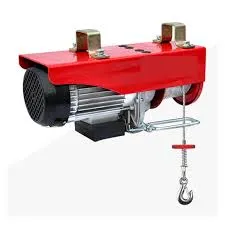


Lever Block Factory A Comprehensive Overview
In the world of industrial equipment, lever blocks are essential tools that facilitate the lifting and moving of heavy loads. Lever block factories play a crucial role in manufacturing these devices, which are commonly used in construction sites, warehouses, and various heavy-duty operations. This article delves into the processes, technologies, and significance of lever block production, bringing to light the various aspects of a lever block factory.
Understanding Lever Blocks
A lever block, also known as a chain block or chain hoist, is a mechanical device that operates on the principle of leverage, employing a chain to lift heavy loads with minimal effort. The primary components of a lever block include a lift chain, a lever, a ratchet, and a hook. By pulling down on the lever, the user can lift a load attached to the hook. The design of lever blocks allows for safe and efficient lifting, making them indispensable in numerous industries.
The Manufacturing Process
The manufacturing of lever blocks involves several key steps that ensure both safety and efficiency in the final product. The process begins with the selection of high-quality materials, typically steel, which provides the necessary strength and durability. The raw materials undergo a series of treatments, including forging and machining, to achieve the desired specifications.
1. Design and Engineering Before production begins, the lever block must be carefully designed. Engineers use computer-aided design (CAD) software to create detailed blueprints that prioritize strength, weight, and usability. Prototyping may also occur to test designs before mass production, ensuring that any potential issues are identified early on.
2. Material Preparation Once designs are finalized, the raw materials are cut, shaped, and treated to enhance their physical properties. This includes processes like heat treatment, which improves tensile strength and reduces brittleness, ensuring the lever block can withstand heavy loads without failure.
3. Assembly Line Production In the factory, an assembly line approach is typically employed. Workers are assigned specific tasks, which helps streamline the production process. Various components, such as the ratchet, gear, and chains, are assembled with precision, ensuring that each part fits together seamlessly. Quality control measures are integrated at each stage to guarantee that the finished products meet safety standards.

4. Testing and Quality Assurance After assembly, lever blocks undergo rigorous testing to ensure they operate safely and efficiently. This often includes load testing and safety inspections. Only products that pass these tests are approved for sale, emphasizing the manufacturer's commitment to quality and safety.
5. Packaging and Shipping Once the lever blocks are deemed ready for market, they are packaged securely to prevent damage during transit. Factories often work with various shipping partners to ensure timely delivery to customers across different regions.
The Role of Technology
In recent years, technology has significantly advanced the production capabilities of lever block factories. Automation and robotics have been integrated into many manufacturing processes, which not only increase efficiency but also reduce the margin for error. Smart manufacturing technologies, such as the Internet of Things (IoT), allow factories to monitor the production process in real-time, ensuring optimal performance and productivity.
Moreover, advancements in materials science have led to the development of lighter yet stronger materials, which can lead to more compact and versatile lever blocks. These innovations contribute to the ongoing evolution of lever blocks, adapting them to meet the demands of modern industries.
Environmental Considerations
As with many industrial sectors, lever block factories are increasingly focused on sustainability. Eco-friendly practices are being adopted throughout the manufacturing process, from sourcing raw materials to recycling waste products. Utilizing energy-efficient machinery and reducing water consumption are vital steps towards minimizing the environmental impact of production.
Conclusion
Lever block factories are critical to the supply chain of various industries, providing essential tools for lifting and moving heavy objects. Through a meticulous manufacturing process that emphasizes quality, safety, and technological advancement, these factories play a pivotal role in ensuring that businesses can operate effectively and safely. As the demand for more efficient and sustainable lifting solutions continues to rise, the evolution and innovation within the lever block manufacturing sector are set to grow, shaping the future of industrial lifting equipment.



